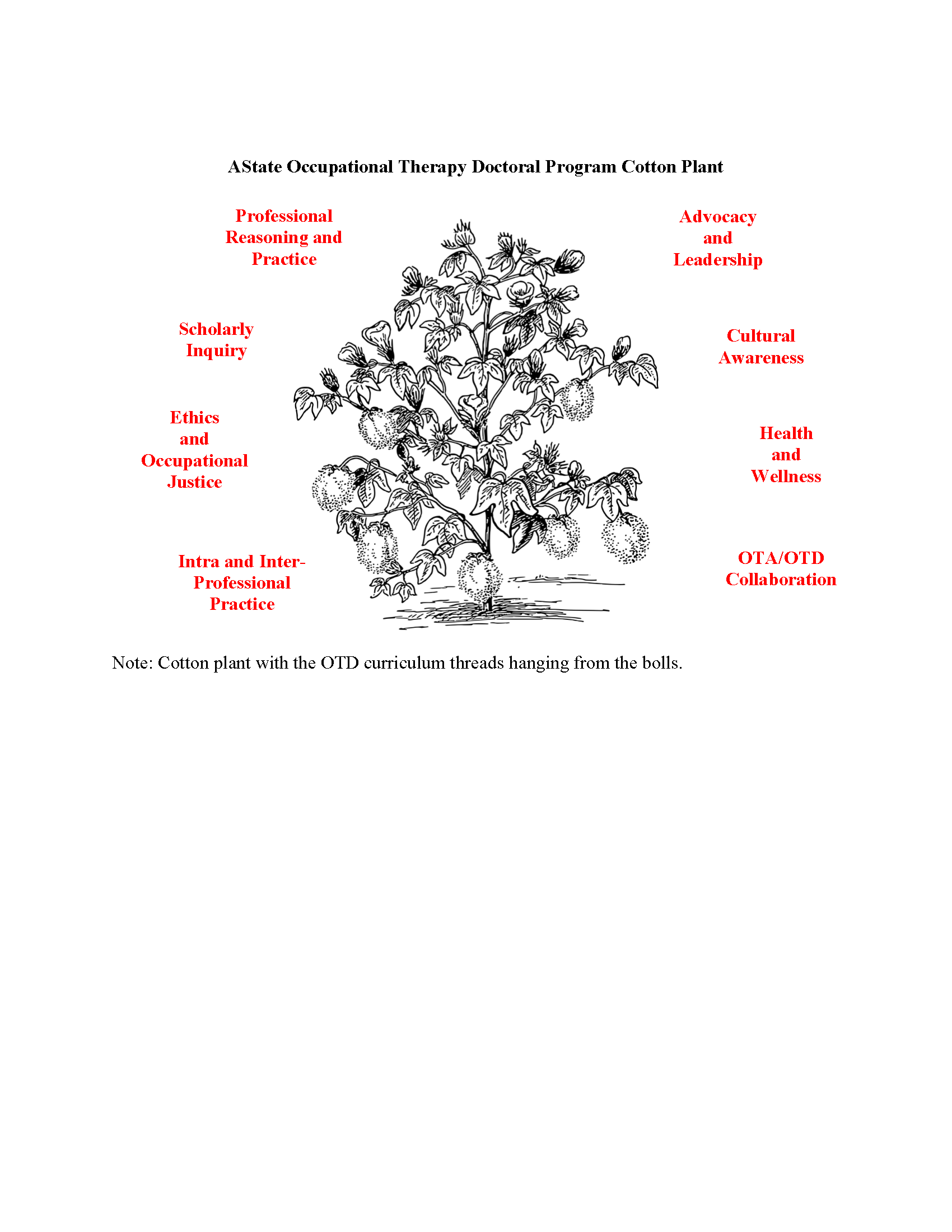College: College of Nursing and Health Professions
Department: Occupational TherapyOTD PROGRAM OUTCOMES
Program results for the National Board for Certification in Occupational Therapy can be found online at: https://www.nbcot.org/Educators-Folder/SchoolPerformance.
| Entering Year/Graduation Year | Students Entering/Students Graduated | Graduation Rate |
| 2019/2022 | 29/28 | 96.55% |
| 2020/2023 | 29/29 | 100% |
| 2021/2024 | 23/19 | 82.60% |
| 2022/2025 | 22/ | |
| 2023/2026 | 17/ | |
| 2024/2027 | 15/ | |
| Total | 81/76 | 93.05% |
OTD Program Purpose
The entry-level Occupational Therapy Doctoral program at Arkansas State University is dedicated to and in agreement with the Accreditation Council for Occupational Therapy Education (ACOTE) requirement that students are educated as “generalists with a broad exposure” (Standards for an Accredited Educational Program for the Occupational Therapist, 2018, preamble) to a variety of traditional areas of practice as well as new and developing areas of practice. Once a student has successfully completed the OTD program didactic courses, all fieldwork experiences, the doctoral Capstone experience, and officially graduated from Arkansas State University, they are required to sit for and pass a national certification exam to become an occupational therapist.
Mission Statements
Arkansas State University
Arkansas State University educates leaders, enhances intellectual growth, and enriches lives. (https://www.astate.edu/)
College of Nursing and Health Professions
The mission of the College of Nursing and Health Professions is to prepare leaders to meet current and future global healthcare demands and positively impact health and wellness in the Mississippi Delta region and beyond through innovative scholarship and outreach. (https://www.astate.edu/college/conhp/index.dot)
Department of Occupational Therapy
The Department of Occupational Therapy in the College of Nursing and Health Professions at Arkansas State University is committed to the development of exceptionally safe, ethical and culturally aware practitioners, life-long learners, advocates, leaders, and scholars who will focus on the unique needs of local communities, the state of Arkansas, the lower Mississippi Delta region and beyond. (https://www.astate.edu/degrees/otd-occupational-therapy)
Vision Statements
Arkansas State University
Arkansas State University aspires to be an academic leader recognized for innovation and quality in teaching and learning, international standing in strategic research areas, and commitment to outreach and service to the Delta and beyond. (https://catalog.astate.edu/content.php?catoid=3&navoid=64)
College of Nursing and Health Professions
Optimize global health and wellness as a premier institution for healthcare education and research. (https://www.astate.edu/college/conhp/index.dot)
Department of Occupational Therapy
We envision graduates from the Department of Occupational Therapy at Arkansas State University who are leaders and scholars that possess the knowledge and skills to advocate for and implement occupational therapy services that improve the health, well-being, and quality of life of those served locally, regionally, and beyond. (https://www.astate.edu/degrees/otd-occupational-therapy)
Context of the Institution
Our Institution
Arkansas State University (AState) is nestled in the northeast corner in close proximity to the “boot heel” of southeast Missouri and northwest corner of Tennessee. Jonesboro, Arkansas is located in the lower Mississippi delta region of the United States forged from an agrarian past with modern key industries of advanced manufacturing, healthcare, logistics and transportation, technology and professional services, and agri-business (http://www.jonesborounlimited.com/key-industries). Arkansas State University plays a vital role in producing a workforce for all of the aforementioned industries in the lower delta region and beyond. The mission of AState is to “educate leaders, enhance intellectual growth and enrich lives” (https://www.astate.edu/a/student-conduct/files/_Student%20Handbook_1819.pdf).
Our College
The history of AState began as an agricultural school in 1909. In January 1967, Arkansas State became Arkansas State University. The nursing program has existed on campus since 1969 and in 1982 the College of Nursing and Health Professions (CoNHP) came into existence ((https://www.astate.edu/info/about-asu/history/historic-timeline/). The college now boasts over 30 undergraduate and graduate degrees and certificates through a wide variety of programs, departments, and the school of nursing (https://www.astate.edu/college/conhp/degrees/).
Our Program
The Occupational therapy department houses both occupational therapy assistant and occupational therapy doctoral programs. The OTD program began in 2015 with the first class graduating in August 2018. As of August 2024, a total of seven cohorts of students graduated from the OTD program.







